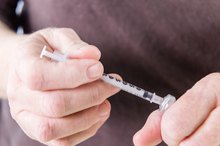What Is a Perfusion Defect?
From the heart, blood travels through arteries to vessels of diminishing diameter, spreading throughout the body. Eventually, it passes through the tiniest of vessels, the capillaries, to perfuse the tissues constituting all systems and organs. Depending on where it occurs and how long it lasts, a defect in perfusion can injure cells, impair an organ or even kill a person.
Significance
“Perfusion” is the circulation of blood through tissues, notes “Taber’s Cyclopedic Medical Dictionary, 19th Ed.” Impeded perfusion causes a deficiency of oxygen in the tissues called hypoxia, observes the book “Human Physiology, 8th Ed.,” by Arthur Vander et al. In fact, the most common cause of hypoxia is reduced perfusion, note Sue Huether and Kathryn McCance in their book “Understanding Pathophysiology, 2nd Ed.”
General Factors
Causes of Low Blood Oxygen Levels
Learn More
Perfusion depends on maintaining normal blood pressure despite changes in body position, muscular activity and circulating blood volume. The body has several ways of accomplishing this, observe Huether and McCance. However, narrowing of blood vessels, sudden decreases in blood volume and blockages in the vessels can lower blood pressure to dangerous levels.
Raynaud Disease
Characterized by a narrowing of the small vessels of the fingers and toes, Raynaud disease exemplifies a perfusion defect. Usually triggered by exposure to cold or emotional distress, the condition disproportionately affects young women, note Huether and McCance. Impeded perfusion causes pallor (an unhealthy pale appearance), numbness and a sensation of cold in the fingers and toes.
Orthostatic Hypotension
Low Hemoglobin and Weight Loss
Learn More
Another perfusion defect is orthostatic hypotension, which occurs when standing up abruptly lowers blood pressure in the head. Although the body has ways to compensate for gravitational effects on circulation, altered blood chemistry, drugs, prolonged immobility, starvation or physical exhaustion can hamper those mechanisms, note Huether and McCance. In orthostatic hypotension, a person experiences dizziness, blurred vision or fainting.
Pulmonary Embolism
To maximize the exchange of carbon dioxide in return for oxygen, blood entering the lungs’ air sacs must contact inhaled air. In other words, perfusion must match ventilation. Any obstruction that blocks an artery in the lung (pulmonary embolism) will reduce perfusion. As a result, inhaled air will fail to make contact with blood. The mismatch can then cause hypoxemia (decreased oxygen concentration in the blood), note Joyce Black et al in their book “Medical-Surgical Nursing, 6th Ed.”
Stroke
In the brain, inadequate perfusion can cause a stroke. In fact, strokes resulting from obstructed blood flow (ischemic strokes) constitute 83 percent of strokes, note Black et al. Obstructions may consist of atherosclerotic plaques on the insides of vessel walls or blood clots formed elsewhere in the body that become dislodged and travel to the brain via the bloodstream, according to Black et al.
Heart Attack
Cardiac cells can endure a lack of perfusion for about 20 minutes before cellular death occurs, according to Huether and McCance. Decreased blood flow to heart tissue leads to oxygen depletion, acid accumulation, electrolyte disturbances and the breakdown of cell membranes. Unless perfusion is quickly restored, a heart attack will result, note Huether and McCance.
Related Articles
References
- “Taber’s Cyclopedic Medical Dictionary, 19th Ed.”; Donald Venes, M.D., Ed.”; 2001
- “Human Physiology, 8th Ed.”; Arthur Vander, James Sherman, and Dorothy Luciano; 2001
- “Understanding Pathophysiology, 2nd Ed.”; Sue E. Huether and Kathryn L. McCance; 2000
- “Medical-Surgical Nursing, 6th Ed.”; Joyce Black, Jane Hokanson Hawks, and Annabelle Keene; 2001
Resources
Writer Bio
Since the mid-1990s, Michael Drwiega has done both scholarly and fiction writing, his dissertation published by UMI and other works recognized in "The Journal of Gerontological Nursing," "The National Catholic Register," "The Writer's Journal" and "Writer's Digest." He holds a doctorate in political science from the University of Iowa.







